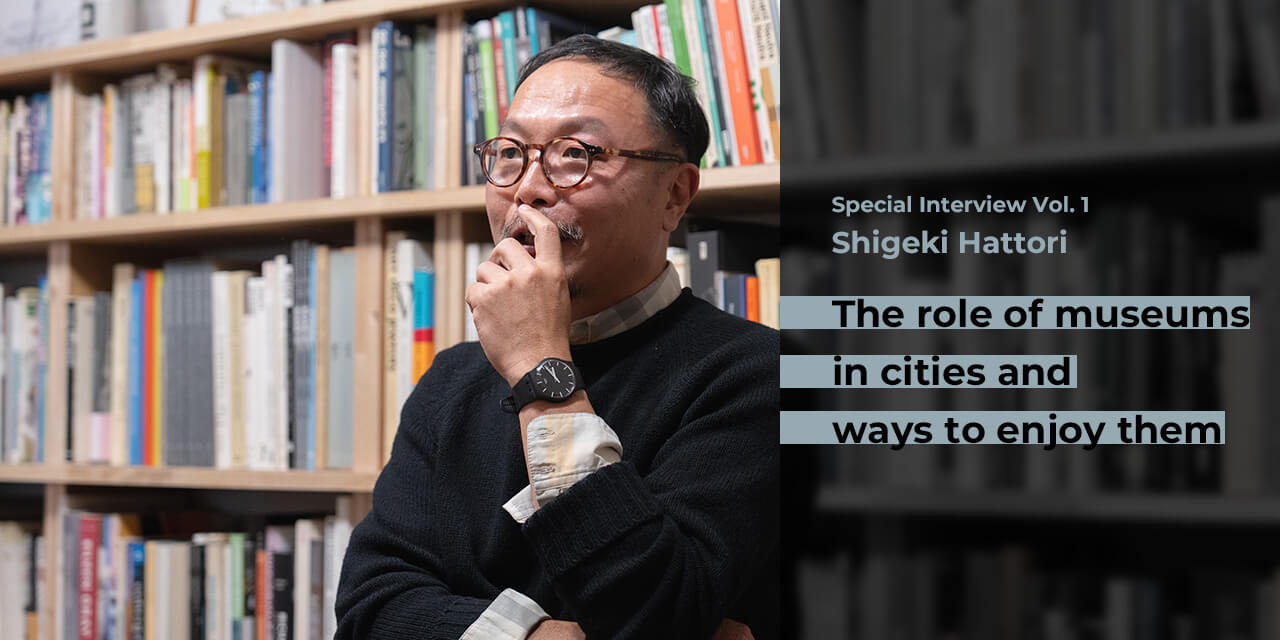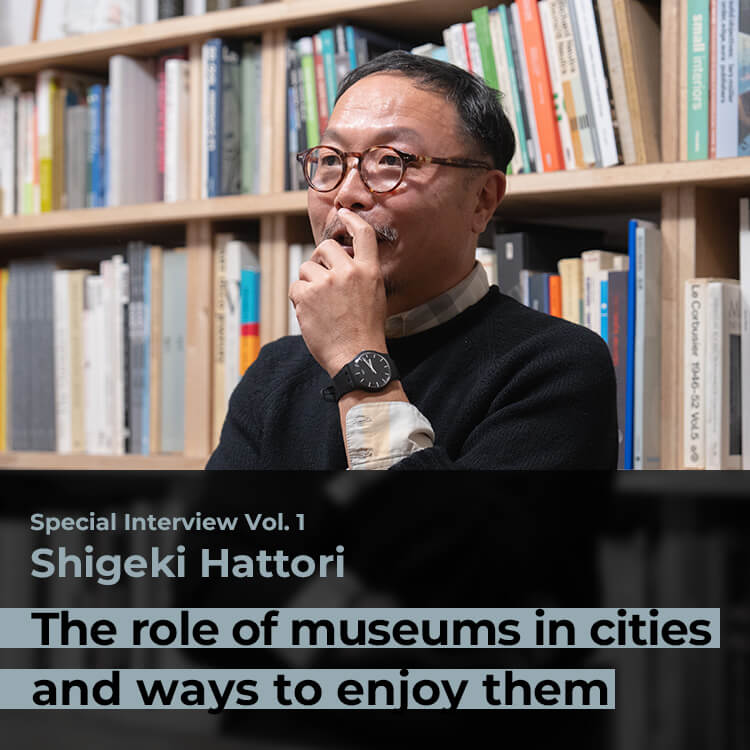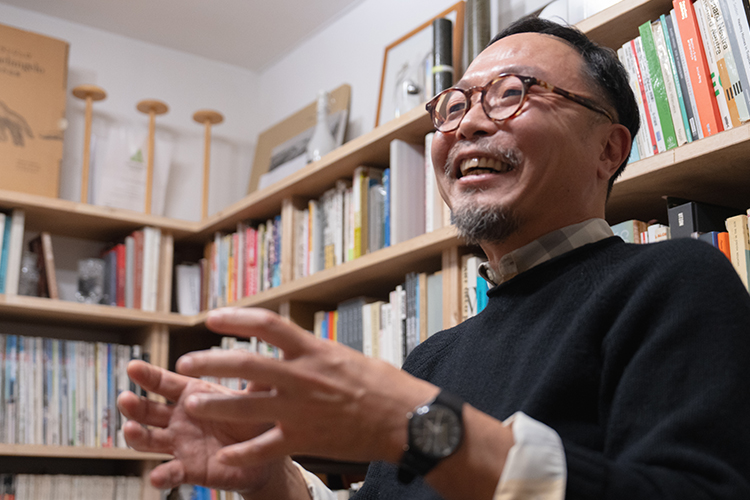Special Interview Vol. 1 Shigeki Hattori


PROFILE
Shigeki Hattori: Representative of graf, creative director
Born in 1970, Mr. Hattori is from Osaka Prefecture. He is the representative of graf, a creative director, and designer. After studying sculpting at an art university, he worked at an interior shop and design company. In 1998, he established graf with friends he met at the interior shop. He has been involved in architecture, interior, and other design, and branding direction. Recently, he has also demonstrated his abilities in social projects such as regional revitalization. He is a professor at the Department of Information Design, Faculty of the Arts, Kyoto University of the Arts.
https://www.graf-d3.com/
THEME
With an eye toward OSAKA-HAKU to be held in 2025, we sit down to interview Mr. Hattori of graf who is highly accomplished in areas including the arts, design, and urban living. He talks about the ways he enjoys museums and his thoughts on their relationship with communities. What he shares builds anticipation for OSAKA-HAKU and is full of opportunities that make us want to take immediate action.

01
In my mind, museums and art galleries are gateways for enjoying communities even more. In my mind, museums and art galleries are gateways for enjoying communities even more.

When I travel abroad, first I go to a city’s history museum and natural history museum, then go around to art galleries to view the present. History and natural history museums have researchers with roots in the region who continually study the history of their community. For example, in the case of a natural history museum, research subjects cover not only history, but also a broad spectrum that includes geographical features, the development of water sources, and creatures living there. Transformations in industry and business become visible by looking at changes in nature, and the way we perceive things also changes through the understanding of the region. At art galleries, too, we can align context with history based on the collection of artworks, and add a variety of knowledge and information to our own perspectives. Changing in this way while searching for perspectives allows us to appreciate a community even more. In my mind, museums and art galleries are gateways for enjoying communities.
I think the six museums participating in OSAKA-HAKU are the same. We tend to think the fields studied by each curator have nothing to do with us, but they’re closely related to our everyday life. They're likely linked to many things, including the roles we play and our work, and are studies on living for the purpose of understanding community and regions. I think these can absolutely nurture our perspectives as I mentioned earlier, as well as spark many realizations, and at times even serve as encounters that encourage us. If it happens to be a time when you’re lost in life, perhaps your doubts will be resolved when you see the words of our predecessors, or view wonderful works of art and they fill you with strength. Facilities like museums and art galleries are places that give us that something. The six museums of OSAKA-HAKU are also each distinctive. It’s nice to enjoy just one, but because they’re all linked together, when you visit them all you’ll probably experience even more encounters, depending on your perspective.
02
Your thinking will be altered and how you approach things will change. That’s the role of museums in communities. Your thinking will be altered and how you approach things will change. That’s the role of museums in communities.

Right now, the world is trying out various ways to achieve well-being, but the origin of well-being can be obtained when intrinsic value is rooted within people and becomes an integral part of them. If we’re not mindful of all things, we won’t be able to obtain well-being and will no longer even be aware of the intrinsic value sprouting within us. These days, having everything provided to us through algorithms has become the norm, leading us to passively accept things as they are provided to us, merely as part of consumer behavior. In my opinion, this was probably caused by paying too much money to the service industry in the 20th century. We’ve become used to being given and provided with things, for better or worse. Of course, there are instances when being provided with something is great, but there are also many things and times when it's better to do it yourself. But, I think we’re no longer mindful of that.
The term, “era of diversity” is often used these days by media and others as a way to live and a new value of the future. You've likely heard or read about it, but having just a vague understanding of it, that in itself has no meaning. What is diversity? Unless you are mindful of that question, nothing will change. Instead of simply being on the receiving end, it’s important to actively do something. I feel the more active you are, the closer you get to the ideal of well-being we all have. If you’re going to accumulate new knowledge and experiences for that purpose, there are museums. If you can gain something from them, then inevitably your thinking will be altered. How you approach things will also change. That’s where the role of museums in communities lies. Moreover, I believe the intrinsic value of museums lies in their role as an integral component of the well-being that the world should strive for.
03
When imagination is sparked through artwork, that time and the experience become even more interesting. When imagination is sparked through artwork, that time and the experience become even more interesting.

“JAR, Porcelain with underglaze cobalt-blue and copper-red-painted lotus design”
The Museum of Oriental Ceramics, Osaka
(Donated by Eiichi Ataka)
Photo by: Tomohiro Muda
I have a five-year-old and a two-year-old, and take them to various museums. On our way back home, they're full of questions, wondering how things work and what they’re like. My children’s imaginations spontaneously take flight. Just listening to that is fun, and many times they've also made my own perspectives change. I feel that children’s perspectives seamlessly connect everyday life and museums. They talk to me as if picking up a single pebble were a major discovery, and are very active even in daily life. It seems to me that actually it’s the adults that tend to distinguish between the everyday and the extraordinary for their own convenience. It’s not because of the extraordinary that amazing discoveries are made, it's that there are discoveries made even in very trivial day-to-day settings. Isn't true intelligence nurtured by being active and using your imagination in that way?
For instance, Nakanoshima Museum of Art, Osaka has numerous artworks that reflect eras. Through the artwork, you can imagine what an era was like, and look at designs and wonder about conventions back then. When you look at a piece from various angles, that time and the experience are bound to become even more interesting. I love folk art, and the Museum of Oriental Ceramics, Osaka has artwork that is said to have amazed even Muneyoshi Yanagi, a Japanese art critic. It’s a jar painted with lotus, but it is said that Yanagi viewed it in a different way than other critics. Looking at it, I can use my imagination to wonder what it was that Muneyoshi Yanagi was looking at and re-enact that different perspective. Being able to have that kind of timeless experience is truly wonderful, isn’t it?
04
I hope OSAKA-HAKU will be an opportunity for people and museums to interactively cross boundaries. I hope OSAKA-HAKU will be an opportunity for people and museums to interactively cross boundaries.


Museums and art galleries today are packaged for each discipline, but if we return to the liberal arts and look at everything, I think that those barriers between disciplines can be overcome. For example, if art and science were to carry out an exchange and Osaka Science Museum were to analyze artworks from the Museum of Oriental Ceramics, Osaka, a deeper analysis could be made about details such as the kind of color created by firing and type of glaze used. A new way of viewing artworks would be made through scientific analysis, and our knowledge would also be further broadened. Instead of doing everything in a single museum, crossing these boundaries would give rise to various impacts. Taken further, it's more than just overcoming barriers; new fields of study would be newly created for the 21st century. Since we live in a world with culture, liberal arts is premised on crossing over communication, economics, and disciplines, so I hope OSAKA-HAKU will become an opportunity to do so.
In addition, the power of the residents, the power of community, and the power of sightseeing grow through OSAKA-HAKU if the people living in Osaka, including ourselves, and the people coming for sightseeing become mindful of life in Osaka and their knowledge is nurtured by encountering the various treasures to be displayed. I expect OSAKA-HAKU to be an event where people and museums interactively cross boundaries. This is my own personal ideal, but it’d be incredible if the entirety of Osaka became a museum. Each and every resident would become just like a curator, discover what they like, and share it. For example, sharing information on social media has become a way to give travel ideas to tourists. Academic facts and real, everyday life would become a new gateway to getting to know Osaka because what is linked to history and art will also be linked to OSAKA-HAKU. I think if we can welcome 2025 with a variety of information available here and there, not only OSAKA-HAKU, but also the community of Osaka will become extremely interesting.